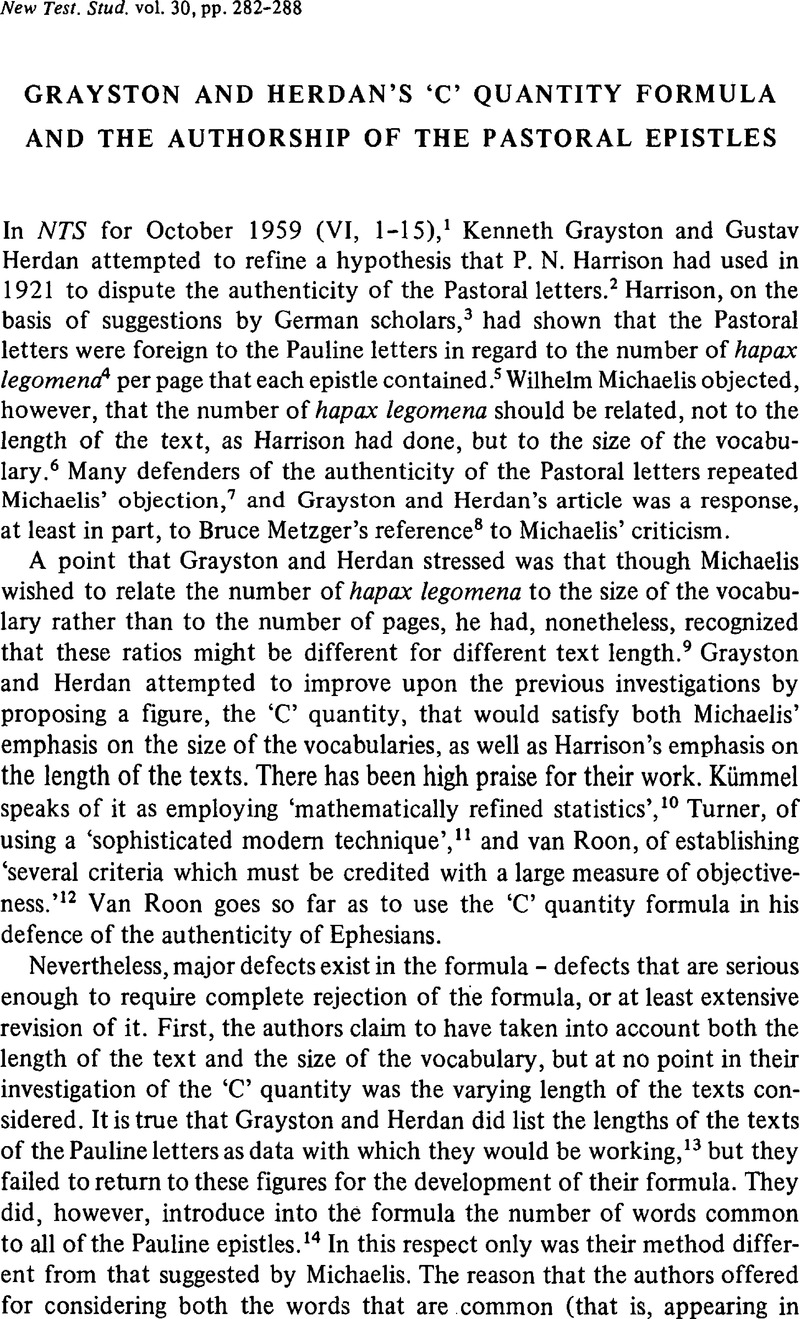Article contents
Grayston and Herdan's ‘C’ Quantity Formula and the Authorship of the Pastoral Epistles
Published online by Cambridge University Press: 05 February 2009
Abstract

- Type
- Short Studies
- Information
- Copyright
- Copyright © Cambridge University Press 1984
References
Notes
[1] Grayston, K. and Herdan, G., ‘The Authorship of the Pastorals in the Light of Statistical Linguistics’, New Testament Studies 6 (1959–1960), pp. 1–15.CrossRefGoogle Scholar
[2] Harrison, P. N., The Problem of the Pastoral Epistles (London: Oxford University Press, 1921), pp. 20–6.Google Scholar
[3] Harrison, , pp. 18–20Google Scholar, gives a brief history of the debate, mentioning the work of Schleier-macher, F., 1807Google Scholar, Mayerhof, E. T., 1838Google Scholar, and Holtzmann, H. J., 1880.Google Scholar
[4] In New Testament studies, the term hapax legomena is frequently used to identify words that occur in only one book, regardless of the number of times. Technically, the term refers only to the words that occur but once within a corpus.
[5] Harrison, , pp. 21–2.Google Scholar
[6] Michaelis, Wilhelm, ‘Pastoralbriefe und Wortstatistik’, Zeitschrift für die neutestamentliche Wissenschaft 28 (1929), pp. 73 f.Google Scholar
[7] Hendriksen, William, Commentary on 1 and 2 Timothy and Titus, Geneva Series Commentaries (London: Banner of Truth Trust, 1959), p. 8.Google ScholarEllis, E. E., ‘The Authorship of the Pastorals: A Resume and Assessment of Current Trends’, Evangelical Quarterly 32 (1960), p. 158.Google ScholarWikenhauser, Alfred, New Testament Introduction, trans. Cunningham, J. (New York: Herder and Herder, 1965), p. 446.Google Scholar
[8] Metzger, Bruce M., ‘A Reconsideration of Certain Arguments Against the Pauline Authorship of the Pastoral Epistles’, Expository Times 70 (1958–1959), pp. 91–4.CrossRefGoogle Scholar
[9] Grayston, and Herdan, , pp. 6–7.Google Scholar
[10] Kümmel, Werner Georg, Introduction to the New Testament, trans. Kee, Howard Clark, revised ed. (Nashville: Abingdon Press, 1975), p. 372.Google Scholar
[11] Moulton, J. H., A Grammar of New Testament Greek, 4 vols. (Edinburgh: T. & T. Clark, 1976), vol. 4 Style, by Nigel Turner, p. 102.Google Scholar
[12] van Roon, A., The Authenticity of Ephesians, Supplements to Novum Testamentum 39 (Leiden: E. J. Brill, 1974), p. 15.Google Scholar
[13] Grayston, and Herdan, , p. 9.Google Scholar
[14] Ibid., pp. 7–9.
[15] Ibid., p. 7.
[16] Ibid., p. 8.
[17] Ibid., p. 10.
[18] Ibid., p. 9.
[19] Computed from Morgenthaler, Robert, Statistik des neutestamentlichen Wortschatzes (Zurich: Gotthelf-Verlag, 1958), p. 173.Google Scholar
[20] Computed from Morgenthaler, , p. 173.Google Scholar
[21] Grayston, and Herdan, , p. 9.Google Scholar
[22] Compiled from Morgenthaler, , pp. 67–157.Google Scholar Words common to all of the Pauline epistles, including the Pastorals: άγάπη, άλλά, άπό, αύтός, γάρ, γίνєσθαι, δέ, δια, εί, οἶδα, єἶναι єίρήνη, єíς, έν, έπί, ἔχεω, ἥ, ήμεῑς, θεóς, Ιησοūς, ῐνα, καί, λέγεω μετά μή (ἠ, τό), ὅς (ἥ, ὅ), ὅτι, ούτος, πᾱς, (πσα, πν), πατήρ, Παῡλος, πίστις, πνεῡμα, ποιεῑν, πρός, τις (τι), ὑμεῑς, χάρις, Χριστός, ώς. Words common to all of the Pauline epistles, including the Pastorals but excluding Philemon; in addition to the words above: δόξα, έαυτοῡ, έκ (έξ), ἔργον, ἔγχεσθαι, κύριος, λόγος, νῡν, ού (ούκ), ἄνθρωπος.
[23] Computed from Morgenthaler, , pp. 164, 173.Google Scholar
[24] Computed from Morgenthaler, , pp. 164, 173.Google Scholar
[25] Grayston, and Herdan, , pp. 8–9.Google Scholar
[26] Compiled from Morgenthaler, , pp. 67–157.Google Scholar Number of words common to James, 1 and 2 Peter and Jude – 60. Number of words found in one, but not the other three: James – 301; 1 Peter – 286; 2 Peter – 178; Jude – 71. The ‘C’ quantities are 64.5%, 63.5%, 59.4% and 57.7% respectively.
[27] Grayston, and Herdan, , p. 9.Google Scholar
[28] Morgenthaler, , p. 173.Google Scholar
- 1
- Cited by




